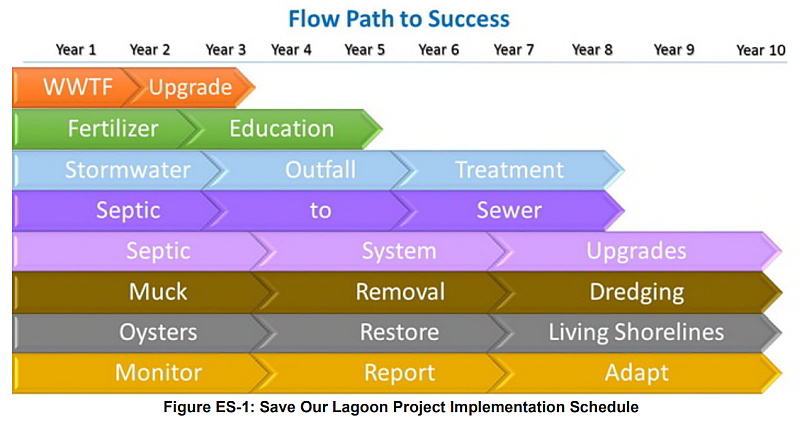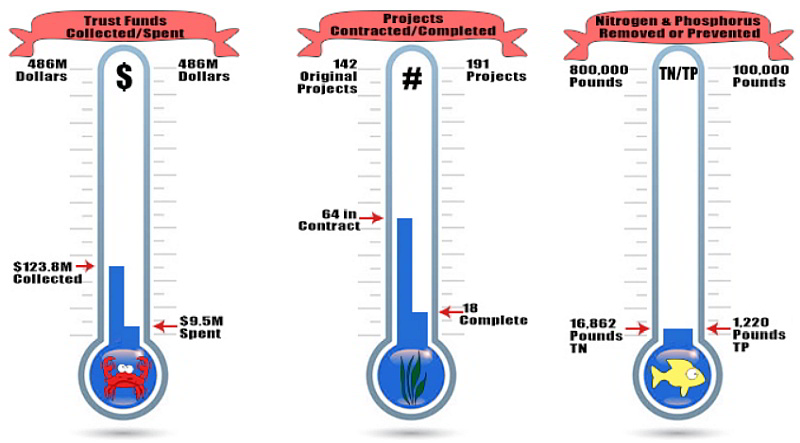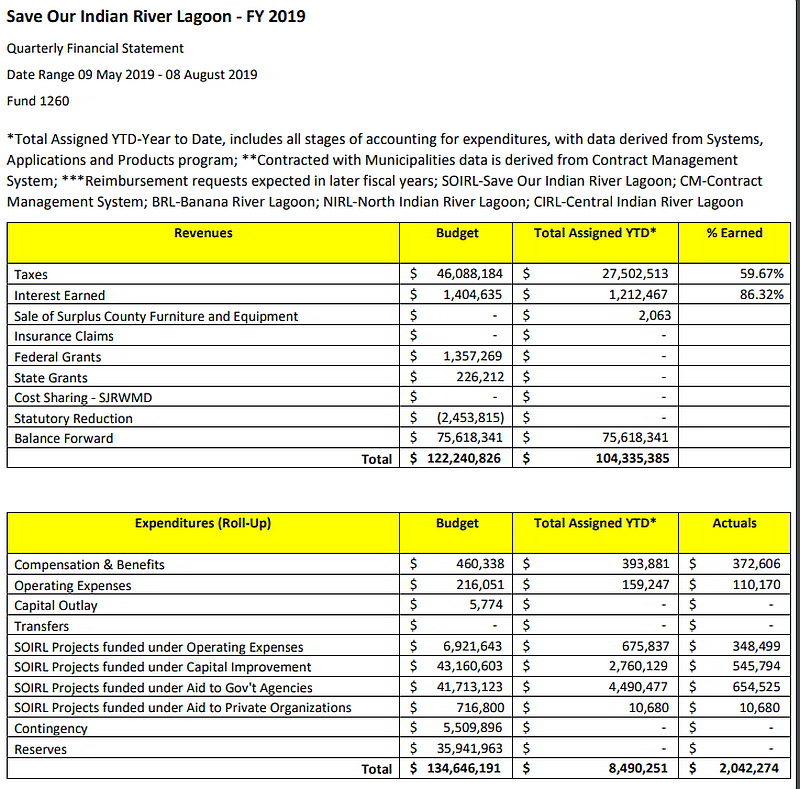Save Our Indian River Lagoon: Difference between revisions
mNo edit summary |
mNo edit summary |
||
| Line 100: | Line 100: | ||
===SOIRL Financial Report=== | ===SOIRL Financial Report=== | ||
[[File:Save-our-indian-river-lagoon-financial-report-201908.jpg|800px|thumb|center|August 2019 SOIRL Financial Report]] | [[File:Save-our-indian-river-lagoon-financial-report-201908.jpg|800px|thumb|center|August 2019 SOIRL Financial Report]] | ||
</div> | |||
<div class="irlcontentmiddle"> | |||
==Video== | |||
Select a video to play or visit the [https://www.youtube.com/channel/UCHtV0jOmRQMpJEtUXfIjAbA Indian River Lagoon News You Tube Channel] - [https://www.youtube.com/playlist?list=PLCiZ8bCTmnlhdxqTWEBCje-oeiLcdUR4- Brevard County Video Playlist]. | |||
{{#evl:yMYGBhNPC8c|Pre-Vote Save Our Indian River Lagoon Presentation 2016-09-22 Part 1 Virginia Barker|1|player=youtube}} | |||
{{#evl:vmL7Ty1qJSs|Pre-Vote Save Our Indian River Lagoon Presentation 2016-09-22 Part 2 Virginia Barker|2|player=youtube}} | |||
<evlplayer w="340" h="220" id="youtube" style="width:inherit;">https://img.youtube.com/vi/yMYGBhNPC8c/0.jpg</evlplayer> | |||
</div> | </div> | ||
<div class="irlcontentbottom"> | <div class="irlcontentbottom"> | ||
Revision as of 09:52, December 31, 2020
After the 2011 super algae blooms caused massive marine life kills and turned the Indian River Estuary's water green, the Brevard Indian River Lagoon Coalition organized a community effort to restore the Indian River Lagoon national estuary. In response to the public's call for action, Brevard County Natural Resources Department developed the Save Our Indian River Lagoon Plan, to conduct local projects, recommended by researchers and scientists, that would improve the lagoon's water quality and restore the estuary's health. The Brevard County Ordinance calling for a half-cent sales tax to fund and implement the Save Our Indian River Lagoon Project was approved by voters on November 8, 2016.
Save Our Indian River Lagoon Organization
Save Our Indian River Lagoon (SOIRL)
Brevard County's Save Our Indian River Lagoon Project researches, plans and implements local projects to improve water quality and the health, productivity, aesthetic appeal, and economic value of the Indian River lagoon. The SOIRL is funded by a ½ cent sales tax approved by Brevard voters on November 8, 2016.
Hierarchy
Government Organization:County Government: Save Our Indian River Lagoon
Affiliations
Parent Organizations: Brevard County Natural Resources Management Department
Subsidiaries: Citizens Oversight Committee
Citizen Oversight Committee
As a requirement of Brevard's SOIRL Program, a Citizen Oversight Committee (COC) was formed to provide transparent implementation and funding of the SOIRL program. The COC includes the county's Natural Resources Department Director and 7 community members. Committee Member Information, Meeting agendas and schedules, Progress and Financial Reports, and other archived documents are available on the COC's webpage.
The Brevard County Natural Resources Department's Save Our Indian River Lagoon Citizen Oversight Committee (COC), chaired by a county commissioner, is composed of local business leaders and stakeholders. The committee receives consultation and support from the Florida Institute of Technology's Indian River Lagoon Research Institute (IRLRI), the St. Johns River Water Management District (SJRWMD), and local IRL advocacy groups. The committee holds monthly public meetings that are live streamed and archived for on-demand viewing.
The COC monitors the SOIRL program to:
- insure transparent implementation and funding of projects,
- modify project plans to reflect neccessary changes
- educate the public on the river's health problems,
- inform the public on the program's progress.
Hierarchy
Government Organization:County Government: Citizens Oversight Committee
Affiliations
Parent Organizations: Save Our Indian River Lagoon Project
History
In order to make an organized effort to save the Indian River Lagoon, the Florida Sierra Club joined with some 30 other IRL advocacy groups to form the Brevard Indian River Lagoon Coalition in early 2016.
The Brevard Coalition's first Call to Action occurred on April 20, 2016, at FIT's Gleason Auditorium in Melbourne, Florida, when 500 people gathered to learn about the river's health problems and what could be done to restore the estuary.[1]
The Coalition, scientists, researchers, and financial experts worked with the county's Natural Resources Management Department Director Virginia Barker, to publish the "Save Our Lagoon Project Plan" on July 27, 2016.[2] The original 10-year plan called for over $176 million for muck dredging, $10 million for stormwater projects, $50.7 million for septic system removals and sewer plant upgrades.[3]
On August 9, 2016, the "Save Our Lagoon Plan" was presented to the Brevard County Commission (BCC). On August 23, 2016, the Commission voted 5-0 to approve the ordinance calling for a referendum election on a half-cent sales tax to fund the plan.[1]
On November 8, 2016, 62.3% of Brevard County voters approved a sales tax to fund the $302 million plan to restore the Indian River Lagoon Estuary.[3]
2016 SOIRL Project Plan Presentation
Excerpt from the 2016 SOIRL Project Plan Executive Summary:
The Indian River Lagoon (IRL) system includes Mosquito Lagoon, Banana River Lagoon, and Indian River. This is a unique and diverse system that connects Volusia, Brevard, Indian River, St. Lucie, and Martin counties. The IRL is part of the National Estuary Program (NEP), one of 28 estuaries of National Significance, and has one of the greatest diversity of plants and animals in the nation. A large portion of the IRL system, 71% of its area and nearly half its length is within Brevard County and provides County residents and visitors many opportunities and economic benefits. View the entire 2016 Save Our Lagoon Project Plan (PDF 91pp 3.1MB).
The Indian River Lagoon (IRL) system includes Mosquito Lagoon, Banana River Lagoon, and Indian River. This is a unique and diverse system that connects Volusia, Brevard, Indian River, St. Lucie, and Martin counties. The IRL is part of the National Estuary Program (NEP), one of 28 estuaries of National Significance, and has one of the greatest diversity of plants and animals in the nation. A large portion of the IRL system, 71% of its area and nearly half its length is within Brevard County and provides County residents and visitors many opportunities and economic benefits.
However, the balance of this delicate ecosystem has been disturbed as development in the area has led to harmful impacts. Stormwater runoff from urban and agricultural areas, wastewater treatment facility (WWTF) discharges, septic systems, and excess fertilizer applications have led to harmful levels of nutrients and sediments entering the lagoon. These pollutants create cloudy conditions in the lagoon and feed algal blooms, both of which negatively affect the seagrass community that provides habitat for much of the lagoon’s marine life. In addition, these pollutants lead to muck accumulation, which releases (fluxes) nutrients and hydrogen sulfide, depletes oxygen, and creates a lagoon bottom that is not hospitable to seagrass, shellfish, or other marine life.
Efforts have been ongoing for decades to address these sources of pollution. Despite significant load reductions, in the last five years, signs of human impact to the IRL system have been magnified. In 2011, the “superbloom” occurred, an intense algal bloom in the Mosquito Lagoon, Banana River Lagoon, and North IRL, as well as a secondary, less intense bloom in the Central IRL. There have also been recurring brown tides; unusual mortalities of dolphins, manatees, and shorebirds; and large fish kills due to low dissolved oxygen from decomposing algae.
Local governments and the St. Johns River Water Management District (SJRWMD) have been proactive in implementing projects over the last several decades. However, to restore the lagoon to health and prosperity, additional funds are needed to eliminate current excess loading and remove the legacy of previous excess loading. Therefore, the County is proposing to place a Save Our Lagoon referendum on the ballot in November 2016. This referendum would provide a funding stream for the types of projects listed in this plan for Brevard County and its municipalities.
This Save Our Lagoon Project Plan outlines local projects planned to meet water quality targets and improve the health, productivity, aesthetic appeal, and economic value of the lagoon. The implementation of these projects is contingent upon funding raised through the referendum. This referendum funding would also allow the County to leverage additional dollars in match funding from state and federal grant programs because the IRL ecosystem is valued not only in Florida but also nationally. Funding implementation of this plan would help to restore this national treasure. Lagoon ecosystem response may lag several years behind completion of nutrient reductions; however, major steps must begin now to advance progress on the long road to recovery.
In the development of this plan, Subject Matter Experts were consulted to provide feedback on the plan elements. The experts all agreed that there is a "critical mass" of nutrient reductions that must be achieved to see a beneficial result in the IRL. This critical level of nutrient reduction will be achieved through the implementation of the projects in this plan. During plan development, it was estimated that the benefit of restoring the lagoon has a present value of $6 billion and a cost of $300 million. Therefore, implementing this plan to restore the IRL is an excellent investment in the future of Brevard County’s community and economy with a benefit to cost ratio of 20:1.
In order to restore the lagoon’s balance, Brevard County seeks to accelerate the implementation of a multi-pronged approach to:
- Reduce pollutant and nutrient inputs to the lagoon from fertilizer, reclaimed water from WWTFs, septic systems, and stormwater;
- Remove the accumulation of muck from the lagoon bottom;
- Restore water-filtering oysters and related lagoon ecosystem services; and monitor progress to
- Respond to changing conditions, technologies, and new information by amending the plan to substitute actions that will be most successful and cost effective for significantly improving the health, productivity, and natural resilience of the IRL.
The portfolio of projects in this plan was selected as the most cost-effective suite of options to achieve water quality and biological targets for the lagoon system. Investment has been distributed among a set of project types with complementary benefits to reduce future risk of failure. Nearly two-thirds (2/3) of the effort and expense is directed toward muck removal to address decades of past excess nutrient loading. Approximately one-third (1/3) of the effort is split among multiple efforts to reduce incoming load to healthy levels, restore natural filtration, measure success, and respond with annual plan updates. The plan projects have been prioritized and ordered to deliver improvements to the lagoon in the most beneficial spatial and temporal sequence. The implementation of this plan is expected to result in a healthy IRL system.
A summary of the types of projects included in the plan, as well as the associated costs and nutrient reduction benefits, are shown in Table ES-1. The timing of the projects is shown in Figure ES-1. Despite the considerable cost of restoration, analysis demonstrates that the economic cost of inaction is double the cost of action. Furthermore, although there are many tangible and intangible benefits for saving the lagoon, the readily estimated return on investment for three benefits – tourism, waterfront property values, and commercial fisheries – is 10% to 26% depending on how quickly the actions in this plan can be completed.[2]
2016 Brevard County SOIRL Ordinance
Excerpt from the 2016 Brevard County SOIRL Ordinance:
AN ORDINANCE OF THE BOARD OF COUNTY COMMISSIONERS OF BREVARD COUNTY, FLORIDA, CALLING A COUNTYWIDE SAVE OUR LAGOON ½ CENT SALES TAX REFERENDUM ELECTION ON NOVEMBER 8, 2016 WITHIN THE TERRITORIAL LIMITS OF BREVARD COUNTY ON THE QUESTION AS TO WHETHER THE BOARD OF COUNTY COMMISSIONERS SHOULD LEVY A ½ CENT INFRASTRUCTURE SALES TAX FOR FINANCING THE COUNTY’S SHARE OF THE COST FOR THE SAVE OUR LAGOON PROJECT PLAN; PROVIDING FOR FINDINGS; CALLING A REFERENDUM; PROVIDING FOR NOTICE OF THE REFERENDUM; PROVIDING FOR BALLOT LANGUAGE; APPROVAL OF SAVE OUR LAGOON PROJECT PLAN; PROVIDING FOR LEVY OF THE ½ CENT SALES TAX FOR RESTORATION OF THE INDIAN RIVER LAGOON; CREATING A SAVE OUR INDIAN RIVER LAGOON PROJECT TRUST FUND; SAVE OUR LAGOON OVERSIGHT COMMITTEE; PROVIDING FOR SEVERABILITY; REPEALER; AND AN EFFECTIVE DATE.[4] Download the entire 2016 Brevard County SOIRL Ordinance.
Save Our Indian River Lagoon in 2019
As of December 2019, the SOIRL Trust Fund has collected 123.8 million dollars. The Trust Fund has spent 9.5 million dollars of a projected 486 million dollars over 10 years.
There are currently 64 ongoing projects and 18 completed projects out of 191 planned projects. The SOIRL Story Map displays an interactive view of the plan's completed and ongoing projects.
Current Nitrogen Removed or Prevented totals 16,862 pounds of a projected total of 800,000 pounds over 10 years. Current Phosphorous Removed or Prevented totals 1,220 pounds of a projected total of 100,000 pounds over 10 years.
View the current SOIRL Progress Dashboard.
2019 Updated SOIRL Plan
Excerpt about 2019 plan updates from the SOIRL website:
Each year, Brevard County updates the Save Our Indian River Lagoon Project Plan to respond to new scientific information, technologies, project opportunities and needs of the Indian River Lagoon. As part of this process, municipalities and other community partners may submit funding requests for projects that can accelerate and/or increase restoration efforts at a comparable cost to the projects listed in the plan. On January 18, 2019, the Citizen Oversight Committee recommended a plan update with 23 new project proposals and reprioritization of wastewater, septic and muck removal projects. The proposed 2019 Update reapportions funds between project types, most notably a $30 million increase for human waste-related projects, a $27 million increase in stormwater projects, and a $37 million decrease in muck removal projects offset by a $21 million increase to provide interstitial water treatment for all dredging projects. The initial 2019 Plan Update was presented to the Board of County Commissioners on February 12, 2019, for their consideration of approval. A Revised Save Our Indian River Lagoon Project Plan 2019 Update[5] was approved by the County Commission during their regular evening meeting on April 9th.[6] View the SOIRL 2019 Project Plan.
SOIRL Financial Report
Video
Select a video to play or visit the Indian River Lagoon News You Tube Channel - Brevard County Video Playlist.
Pre-Vote Save Our Indian River Lagoon Presentation 2016-09-22 Part 1 Virginia Barker Pre-Vote Save Our Indian River Lagoon Presentation 2016-09-22 Part 2 Virginia Barker
Web Links
- SOIRL Project Story Map
- Save Our Indian River Lagoon
- Citizen Oversight Committee
- Sierra Club Florida Chapter
- Brevard Indian River Coalition
References
- ↑ 1.0 1.1 Sierra Club Florida, published 11/2016 retrieved 12/31/2019
- ↑ 2.0 2.1 Save Our Lagoon Project Plan 2016 (PDF 91pp 3.1MB), published 07/27/2016, retrieved 12/31/2019
- ↑ 3.0 3.1 Indian River Lagoon cleanup tax passes, published 11/08/2016, retrieved 12/31/2019
- ↑ Brevard SOIRL Ordinance 2016
- ↑ SOIRL Project Plan 2019
- ↑ Save Our Indian River Lagoon Website, retrieved:01/01/2020






